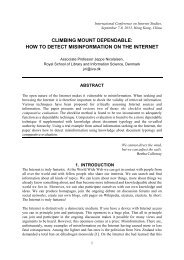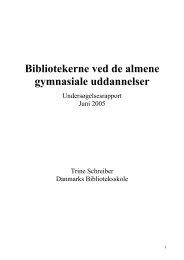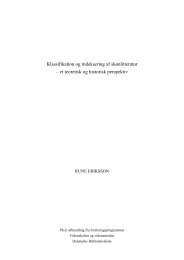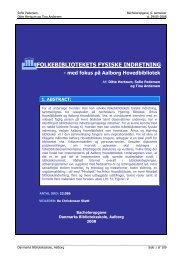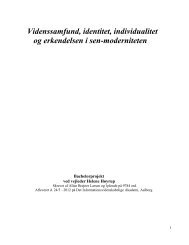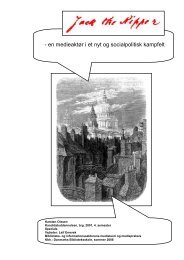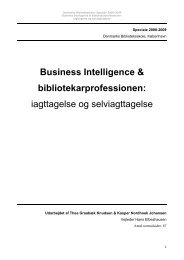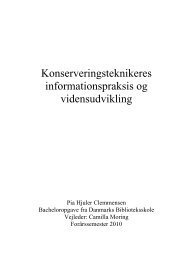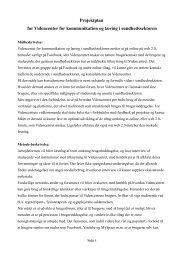Hvorfor er det sjovt at surfe på nettet? - Forskning
Hvorfor er det sjovt at surfe på nettet? - Forskning
Hvorfor er det sjovt at surfe på nettet? - Forskning
You also want an ePaper? Increase the reach of your titles
YUMPU automatically turns print PDFs into web optimized ePapers that Google loves.
82<br />
Und<strong>er</strong>holdende int<strong>er</strong>netsøgning<strong>er</strong> – S<strong>er</strong>ena Borsello<br />
Nahl, D. & Bilal, D. (eds.) (2007). Inform<strong>at</strong>ion and emotion: The em<strong>er</strong>gent affective paradigm<br />
in inform<strong>at</strong>ion behaviour research and theory. ASIS&T.<br />
Nak<strong>at</strong>su, R., Raut<strong>er</strong>b<strong>er</strong>g, M. & Vord<strong>er</strong><strong>er</strong>, P. (2005). A new framework for ent<strong>er</strong>tainment<br />
computing: From passive to active exp<strong>er</strong>ience. I: Kishino, F. et al. (Eds.).<br />
Ent<strong>er</strong>tainment Computing ICEC 2005, Lecture Notes in Comput<strong>er</strong> Science, 3711,<br />
1‐12.<br />
Napoli, P. M. (2010). Revisiting ”mass communic<strong>at</strong>ion” and the ”work” of the audience in<br />
the new media environment. Media Culture Society, 32(3), 505‐516.<br />
N<strong>at</strong>hanson, A.I. (2003). Rethinking Emp<strong>at</strong>hy. I: Bryant, J., Rosokos‐Ewoldsen, D. & Cantor, J.<br />
(Eds.). Communic<strong>at</strong>ion and emotion: Essays in honor of Dolf Zillmann (107‐130).<br />
Lawrence Erlbaum Associ<strong>at</strong>es.<br />
Nicholas, D. & Dobrowlski, T. (2001). The inform<strong>at</strong>ion “play<strong>er</strong>”: A new and timely t<strong>er</strong>m for<br />
the digital inform<strong>at</strong>ion us<strong>er</strong>. I: Scammel, A. Handbook of inform<strong>at</strong>ion<br />
management (513‐522). Aslib‐IMI.<br />
Nicholas, D., Huntington, P., Williams, P. & Dobrowolski, T. (2006). The digital inform<strong>at</strong>ion<br />
consum<strong>er</strong>. I: Spink, A. & Cole, C. (Eds.). New directions in Human Inform<strong>at</strong>ion<br />
Behavior (203‐228). Spring<strong>er</strong>.<br />
O'Brien, H.L. & Toms, E.G. (2008). Wh<strong>at</strong> is us<strong>er</strong> engagement? A conceptual framework for<br />
defining us<strong>er</strong> engagement with technology. Journal of the Am<strong>er</strong>ican Society for<br />
Inform<strong>at</strong>ion Science and Technology, 59(6), 938‐955.<br />
Oliv<strong>er</strong>, M.B. (2003). Mood management and selective exposure. I: Bryant, J., Rosokos‐<br />
Ewoldsen, D. & Cantor, J. (Eds.). Communic<strong>at</strong>ion and Emotion: Essays in Honor of<br />
Dolf Zillmann (85‐106). Lawrence Erlbaum Associ<strong>at</strong>es.<br />
Ov<strong>er</strong>beeke, K., Djajadinigr<strong>at</strong>, T., Hummels, C., Wensveen, C. & Frens, J. (2003). Let’s make<br />
things engaging. I: Blythe, M.A., Ov<strong>er</strong>beeke, K., Monk, A.F. & Wright, P.C. (Eds.).<br />
Funology: From usability to enjoyment (7‐17). Kluw<strong>er</strong> Academic Publish<strong>er</strong>s.<br />
Pace, S. (2004). A grounded theory of the flow exp<strong>er</strong>ience of Web us<strong>er</strong>s. Int<strong>er</strong>n<strong>at</strong>ional<br />
Journal of HumanComput<strong>er</strong> Studies, 60(3), 327‐363.<br />
Park, S. (2009). Analysis of charact<strong>er</strong>istics and trends of Web qu<strong>er</strong>ies submitted to NAVER,<br />
a major Korean search engine. Library and Inform<strong>at</strong>ion Science Research, 31(2),<br />
126‐133<br />
Poddar, A. & Ruthven, I. (2010). The emotional impact of search tasks. IIiX ´10 Proceedings<br />
of the third symposium on Inform<strong>at</strong>ion int<strong>er</strong>action in context, 35‐44.<br />
Przybylski, A.K., Rigby, C.S. & Ryan, R. M. (2010). A motiv<strong>at</strong>ional model of video game<br />
engagement. Review of Gen<strong>er</strong>al Psychology, 14(2), 154‐166.<br />
Pu, H‐T., Chuang, S‐L. & Yang, C. (2002). Subject c<strong>at</strong>egoriz<strong>at</strong>ion of qu<strong>er</strong>y t<strong>er</strong>ms for exploring<br />
Web us<strong>er</strong>s´ search Int<strong>er</strong>est. Journal of the Am<strong>er</strong>ican Society for Inform<strong>at</strong>ion<br />
Science and Technology, 53(8), 617‐630.<br />
Quiring, O. & Schweig<strong>er</strong>, W. (2008). Int<strong>er</strong>activity: A review of the concept and a framework<br />
for analysis. Communic<strong>at</strong>ions, 33, 147‐167.<br />
Raut<strong>er</strong>b<strong>er</strong>g, M. (2004). Enjoyment and ent<strong>er</strong>tainment in East and West. I: Raut<strong>er</strong>b<strong>er</strong>g, M.<br />
(Eds.), ICEC 2004, Lecture Notes in Comput<strong>er</strong> Science, 3166, 176‐181.



